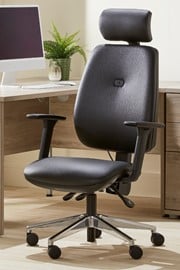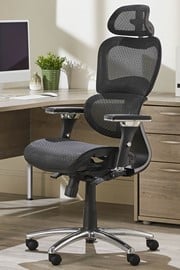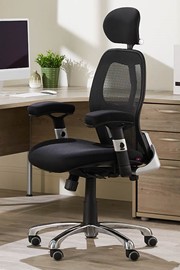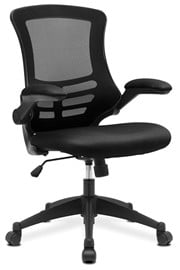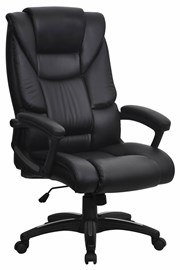Advantages of a Headrest
A headrest is a common feature of office chairs that provides support to the head and neck. Here are some of the advantages of using a headrest:
Reduces Neck Pain: A headrest helps to keep the neck in a neutral position, reducing the strain on the neck muscles. This can help to prevent neck pain and stiffness.
Improves Posture: A headrest encourages good posture by keeping the head and neck in alignment with the spine. This can help to reduce back pain and other posture-related problems.
Enhances Comfort: A headrest provides a comfortable place to rest the head during breaks, reducing fatigue and increasing productivity.
Disadvantages of a Headrest
While a headrest can provide many benefits, there are also some disadvantages to consider:
Limits Movement: A headrest can limit movement, making it difficult to turn the head or look around the room. This can be especially problematic for people who need to move around frequently during the day.
May Not Fit Everyone: A headrest may not be suitable for everyone. Some people may find that the headrest is too high or too low, causing discomfort or pain. This is especially true for those office chairs with a fixed headrest.
Adds to the Cost: Adding a headrest to an office chair can increase the cost of the chair. This may be a concern for people who are on a tight budget.
Overall, a headrest can be a useful feature for an office chair, providing support, comfort, and improved posture. However, it may not be suitable for everyone, and it is important to consider the potential limitations before making a purchase.
Choosing the Right Headrest
When it comes to choosing the right headrest for an office chair, there are a few factors to consider. A good headrest can help reduce neck and shoulder pain, improve posture, and increase overall comfort during long periods of sitting.
Material
The material of the headrest is an important consideration. A breathable mesh material can help keep you cool and comfortable. Leather or faux leather options can provide a sleek and professional look, but may not be as breathable. It's important to choose a material that suits your needs and preferences.
Adjustability
An adjustable headrest is essential for finding the perfect fit. Look for a headrest that can be adjusted in height and depth to accommodate different body types and sitting positions. Some headrests may also have a tilt function, allowing you to adjust the angle of the headrest for maximum comfort.
Compatibility
Not all headrests are compatible with all office chairs. Make sure to check the compatibility of the headrest with your specific chair model before making a purchase. Some headrests may come with adapters to fit different chairs, while others may only be compatible with certain models.
Final Thoughts
In summary, the decision to use a headrest on an office chair is a personal preference. However, it is important to consider the potential benefits and drawbacks before making a decision.
Based on the research, a headrest can provide additional support to the neck and shoulders, which can reduce strain and discomfort. This is particularly important for individuals who spend long hours sitting at a desk.
On the other hand, some people may find headrests uncomfortable or restrictive. Additionally, some office chairs may not be designed to accommodate a headrest, which could lead to an ill-fitting or unstable attachment.
Ultimately, the decision to use a headrest should be based on individual comfort and ergonomic needs. It is recommended to try out an office chair with and without a headrest to determine personal preference.
Overall, a headrest can be a useful addition to an office chair for those who value extra support, but it is not essential for everyone.
Frequently Asked Questions
Is a headrest necessary for an ergonomic office chair?
No, a headrest is not necessary for an ergonomic office chair. However, it can provide added comfort and support for those who spend long hours sitting at a desk.
What are the benefits of having a headrest on an office chair?
Having a headrest on an office chair can help to reduce strain on the neck and shoulders, especially for those who spend long periods of time sitting in front of a computer. It can also promote better posture and reduce the risk of developing musculoskeletal disorders.
Can an office chair be ergonomic without a headrest?
Yes, an office chair can be ergonomic without a headrest. A chair that is designed to support the natural curves of the spine and promote good posture can still be considered ergonomic, even if it does not have a headrest.
Are there any downsides to using an office chair with a headrest?
One potential downside to using an office chair with a headrest is that it may limit the range of motion of the neck and head. This can be problematic for those who need to frequently look up or move their head in different directions while working.
What should I look for when choosing an office chair with a headrest?
When choosing an office chair with a headrest, it is important to look for one that is adjustable and can be positioned to support the natural curvature of the neck and spine. The headrest should also be comfortable and provide adequate support without restricting movement.

